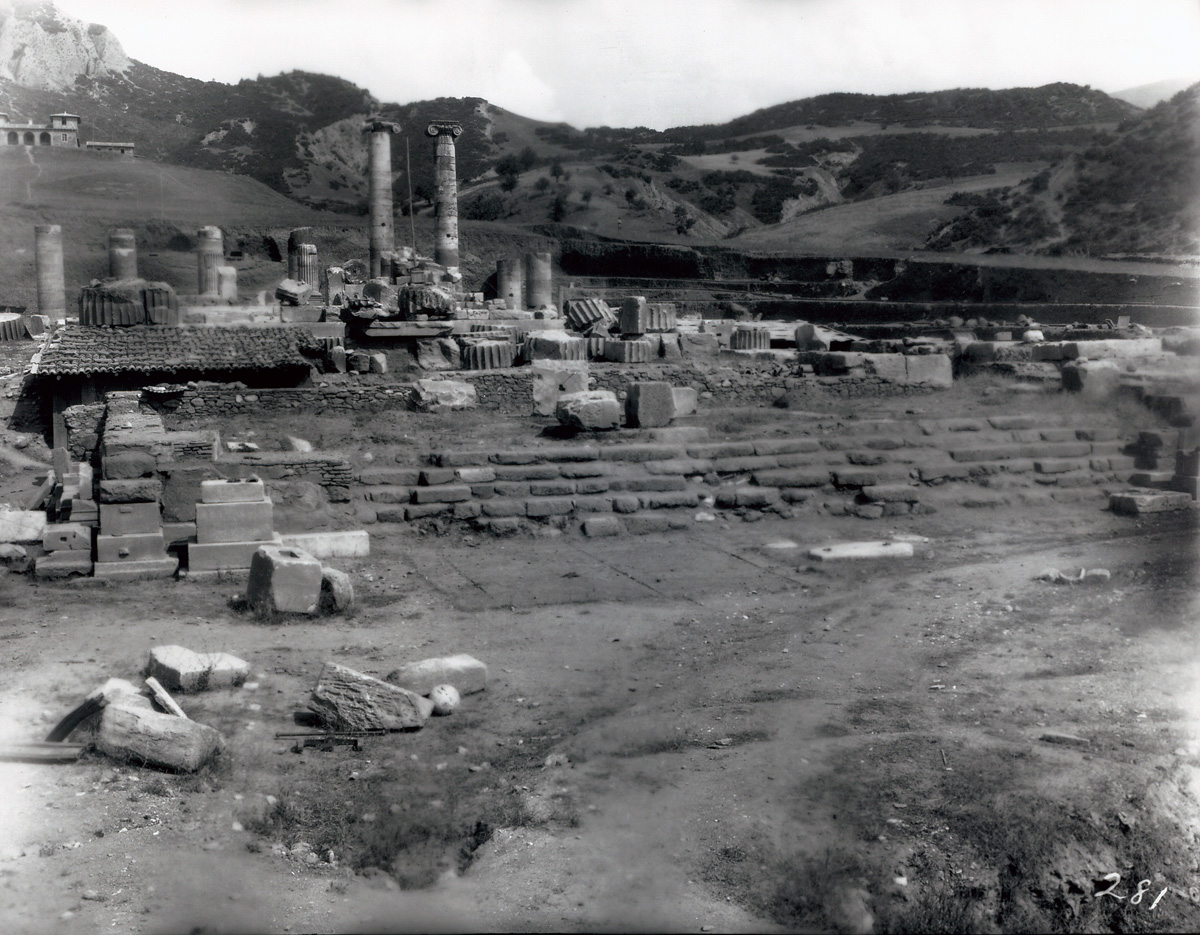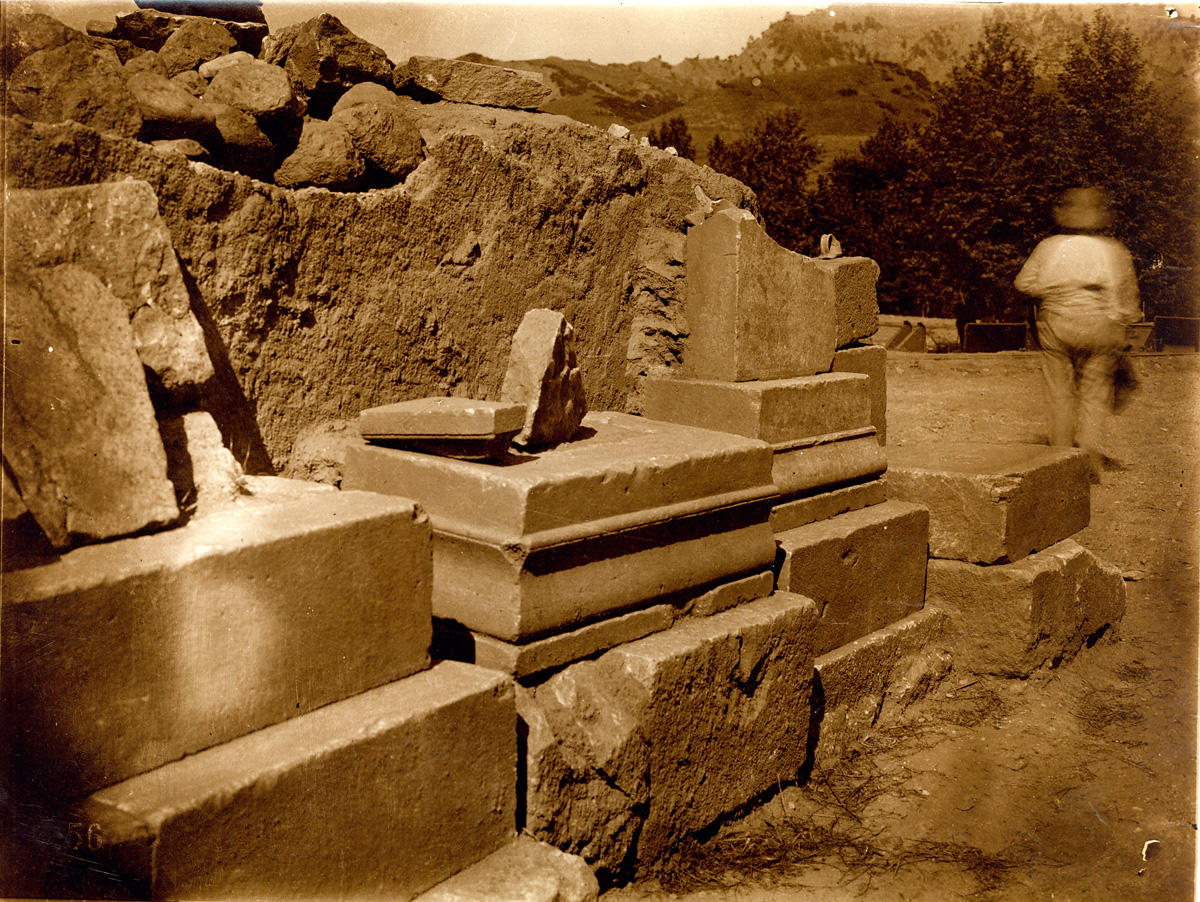The Altar of Artemis
The Lydian Altar
The Altar of Artemis (or “Lydian Altar”) is the oldest preserved building in the sanctuary of Artemis, and was the focus of its ritual and ceremony (figs. 2, 3, 4, 5, 6). It has two main building phases, the first of which is probably older than the temple, the second contemporary with the Hellenistic phase of the temple of Artemis.
-

Fig. 2
Plan of the Temple and Altar of Artemis, by H.C. Butler plan with updates 2002-2012 (©Archaeological Exploration of Sardis/President and Fellows of Harvard College)
-

Fig. 3
Plan of the Lydian Altar, by Butler (From Butler, Sardis I: The Excavations, fig. 35)
-

Fig. 4
Plan of the Lydian Altar (©Archaeological Exploration of Sardis/President and Fellows of Harvard College)
-

Fig. 5
View of the Lydian Altar during excavation in 1910 (Howard Crosby Butler Archive, Department of Art and Archaeology, Princeton University)
-

Fig. 6
General view of temple and altar, before restoration (2007) (©Archaeological Exploration of Sardis/President and Fellows of Harvard College)
Phase 1 (LA-1)
The earlier structure is a squarish stepped foundation made of limestone tufa (figs. 4, 7, 8). It now looks like a stepped pyramid, but the coarse stone and rough workmanship suggest that the preserved courses were merely underground foundations, and the building above, which may have been much more finely made, has been entirely destroyed. This is perhaps the oldest structure in the sanctuary, dating to the period when Sardis was ruled by the Achaemenid Persians, perhaps 500-400 BC. There is no evidence for a temple in this period; the Lydians may have worshipped in a different manner from the Greeks and Romans.
-

Fig. 4
Plan of the Lydian Altar (©Archaeological Exploration of Sardis/President and Fellows of Harvard College)
-

Fig. 7
View of altar LA-1 (©Archaeological Exploration of Sardis/President and Fellows of Harvard College)
-

Fig. 8
Reconstruction drawing of altar LA-1 (phase 1) (©Archaeological Exploration of Sardis/President and Fellows of Harvard College)
Phase 2 (LA-2)
In a later period, this building was partly dismantled and some of its blocks incorporated in a new, larger structure that completely enclosed and buried the earlier foundations (figs. 6, 9, 10). This new building probably formed an enclosure or platform for a smaller altar, whose floor was higher than the level preserved today, on which animal sacrifices, libations, and other offerings were made. A set of marble stairs across the front of the building led to this higher level. These blocks were mostly robbed out in antiquity, but a few survive at the sides of the building. The walls were originally finely stuccoed; traces of stucco are preserved, and some are protected by modern mortar.
A row of bases for stelai — slabs of stone bearing inscriptions, reliefs, or both — was set against the left side of the altar, and more bases are found on either side of the stairs, and in two rows leading up to the temple and altar (figs. 11, 12). When excavated, fragments of some of these stelai were still found in situ. Some at least seem to be reused, ancient artifacts, set up here at a relatively late date, after the altar was stuccoed. The stelai reflect the great interest of later Sardians in their own ancient history.
A peculiar feature of the altar is that it was so close to the temple that it was eventually connected to the altar by walls, now mostly missing (figs. 2, 3). This led to a reversal of the usual arrangement of temple and altar. In standard Greek practice the altar faced away from the temple; here the stairs up to the altar faced towards the temple, and, in fact, might have formed the main entrance to the temple in its final phase.
-

Fig. 6
General view of temple and altar, before restoration (2007) (©Archaeological Exploration of Sardis/President and Fellows of Harvard College)
-

Fig. 9
Reconstruction of altar LA-2 (phase 2) (©Archaeological Exploration of Sardis/President and Fellows of Harvard College)
-

Fig. 10
Reconstruction of altar LA-2 (phase 3) (©Archaeological Exploration of Sardis/President and Fellows of Harvard College)
-

Fig. 11
Reconstruction of altar LA-2 (phase 4) (©Archaeological Exploration of Sardis/President and Fellows of Harvard College)
-

Fig. 12
Stelai as discovered against north side of LA-2 (Howard Crosby Butler Archive, Department of Art and Archaeology, Princeton University)
-

Fig. 2
Plan of the Temple and Altar of Artemis, by H.C. Butler plan with updates 2002-2012 (©Archaeological Exploration of Sardis/President and Fellows of Harvard College)
-

Fig. 3
Plan of the Lydian Altar, by Butler (From Butler, Sardis I: The Excavations, fig. 35)
Conservation and Restoration
The altar was restored in 2010-2012, with the support of the J.M. Kaplan Fund (figs. 13, 14). The travertine stair blocks are modern replacements of the original marble stairs, to protect the ancient foundations. The walls were rebuilt to the state in which they were found in 1910 and capped with slate.
-

Fig. 13
Lydian Altar during restoration (©Archaeological Exploration of Sardis/President and Fellows of Harvard College)
-

Fig. 14
General view of temple and altars LA-1 and LA-2, after conservation in 2012 (©Archaeological Exploration of Sardis/President and Fellows of Harvard College)
Further Reading
Butler, Sardis 1: The Excavation; Sardis 2: The Temple of Artemis; Hanfmann and Waldbaum: A Survey of Sardis and the Major Monuments Outside the City Walls 88-103; Ratté, Lydian Architecture: Ashlar Masonry Structures at Sardis, 123-125; Cahill, “The Sanctuary of Artemis at Sardis: Preliminary Report, 2002-2012”.












